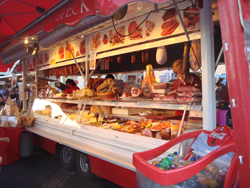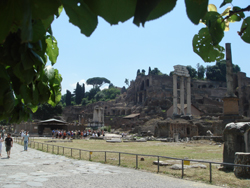 After a great nights sleep at the Hotel
Sacher, we crossed the Salzach river into Salzburgs
Altstadt (Old Town.) Initially, we turned into the Gstatteng
to a have a quick look at the houses which are hollowed into
the sheer cliff face of the Monchsberg. Whats amazing to a
non-architect-type about these pastel coloured houses is that
the cliff doesn't collapse through the roofs of the house.
After a great nights sleep at the Hotel
Sacher, we crossed the Salzach river into Salzburgs
Altstadt (Old Town.) Initially, we turned into the Gstatteng
to a have a quick look at the houses which are hollowed into
the sheer cliff face of the Monchsberg. Whats amazing to a
non-architect-type about these pastel coloured houses is that
the cliff doesn't collapse through the roofs of the house.
Heading back towards the central Altstadt, we stopped at the Greek Catholic Church of St Mark (at the corner of Franz-Josef Kai and Gstatteng.) The interior is bright and airy in the Baroque-style. The Church of St Mark was built between 1699-1705 under the reign the Prince-Archbishop of Salzburg Johann Ernst Graf Thun. The previous church on this site was built between 1616-1618 but was, however, destroyed by a mountain-slide in 1669. The Ursuline Nuns, to whome the Church was given over, comepleted their adjacent convent in 1720. However, the Nuns moved out of the convent in 1957. In 1973, the church was closed to the public as it was close to collapse. After an estimated USD2,000,000 restoration the church was stabilised. In 1999, the Church was put at the disposition of the Ukranian Greek Catholic Church.
 Further
into town, we visited the Church of St Blasius (Getreidegasse,
5013 Salzburg) which was originally constructed for the
peoples hospital in 1327 and consecrated in 1350. The rather
dark Gothic / Romanesque Church also boasts some Baroque elements.
Of particular note are the tabernacle which dates from 1481,
and an altarpiece by Paul Trodger dating from 1746 depicting
the adoration of the Magi. The High Altar is after a design
by Louis Grenler and dates from 1785 and the cruicifixion grouping
is by Franz Hitzl. The stained glass dates from 1947/8 is from
Albert Birkle.
Further
into town, we visited the Church of St Blasius (Getreidegasse,
5013 Salzburg) which was originally constructed for the
peoples hospital in 1327 and consecrated in 1350. The rather
dark Gothic / Romanesque Church also boasts some Baroque elements.
Of particular note are the tabernacle which dates from 1481,
and an altarpiece by Paul Trodger dating from 1746 depicting
the adoration of the Magi. The High Altar is after a design
by Louis Grenler and dates from 1785 and the cruicifixion grouping
is by Franz Hitzl. The stained glass dates from 1947/8 is from
Albert Birkle.
 The
courtyard of the Speilzeugmuseum was
playing home to a flea market. Which meant I could spend all
of five minutes rummaging around some interesting old cameras
and debating whether I wanted one or not. But then decided
I'd got enough of them already. Of course I still wanted one
- but left empty handed regardless. After the market we stopped
for coffee directly opposite the horse trough (pictured) which
is one of the more elaborate horse troughs I've seen in recent
years. And who says we've had progress? There's no petrol stations
like this now!
The
courtyard of the Speilzeugmuseum was
playing home to a flea market. Which meant I could spend all
of five minutes rummaging around some interesting old cameras
and debating whether I wanted one or not. But then decided
I'd got enough of them already. Of course I still wanted one
- but left empty handed regardless. After the market we stopped
for coffee directly opposite the horse trough (pictured) which
is one of the more elaborate horse troughs I've seen in recent
years. And who says we've had progress? There's no petrol stations
like this now!
 Heading towards the Collegial Church - a large Baroque structure
by Fischer von Erlach - we encountered the market with an enjoyable
assortment of local produce on offer. There were cheeses and,
being German-speaking Europe, a selection
of sausages. After perusing some of the stalls, we stopped
at the stall of Schroffenbrennerei
Grödig - a local producer of such delights as kirsch
and various forms of fruit based liquor, a selection of which
were open for tasting. The English-speaking stall-man was friendly
as he chatted us through what he had to offer. Schroffenbrennerei
Grödig are a local business and employ a septagenerian
master who has, apparently, been with the firm for some decades.
I've never met this master but, judging from the produce on
offer, his palate is excellent. We knew were going to have
some Cheese Fondue over the Christmas period - so snapped up
a bottle of the very fine kirsch on offer and a bottle of Raspberry
Liqour for good measure. The Raspberry liquor retains strong
natural flavours of the fruit and (I don't know if I can use
a wine word for this) has excellent finish. The kirsch was
simply the best kirsch I've ever drunk - simply marvellous. (Additional
- as suspected the kirsch really was a great accompaniment
to our Swiss Cheese Fondue.)
Heading towards the Collegial Church - a large Baroque structure
by Fischer von Erlach - we encountered the market with an enjoyable
assortment of local produce on offer. There were cheeses and,
being German-speaking Europe, a selection
of sausages. After perusing some of the stalls, we stopped
at the stall of Schroffenbrennerei
Grödig - a local producer of such delights as kirsch
and various forms of fruit based liquor, a selection of which
were open for tasting. The English-speaking stall-man was friendly
as he chatted us through what he had to offer. Schroffenbrennerei
Grödig are a local business and employ a septagenerian
master who has, apparently, been with the firm for some decades.
I've never met this master but, judging from the produce on
offer, his palate is excellent. We knew were going to have
some Cheese Fondue over the Christmas period - so snapped up
a bottle of the very fine kirsch on offer and a bottle of Raspberry
Liqour for good measure. The Raspberry liquor retains strong
natural flavours of the fruit and (I don't know if I can use
a wine word for this) has excellent finish. The kirsch was
simply the best kirsch I've ever drunk - simply marvellous. (Additional
- as suspected the kirsch really was a great accompaniment
to our Swiss Cheese Fondue.)
 After
pottering around the quite convivial market, we entered Collegiate
Church (Kollegienkirche) which dominates the market square.
Designed by by Fischer von Erlach, the pre-eminent Austrian
Baroque architect, the Collegiate Church (Kollegienkirche)
boasts a distinctive convex façade is remicisent of
a giant oriel window. The interior is bright and spacious and
incorporates a high altar by Anton Pfaffinger (1740) with classical
columns to represent the Seven Pillars of Wisdom. Johann Michael
Rottmayr produced contributed the altar paintings. Interestingly,
the Stations of the Cross (the Stations depict the Passion
of Christ) adorn the spandrels through the aisles either side
of the nave and one continues from where the other leaves off
- quite a cohesive design.
After
pottering around the quite convivial market, we entered Collegiate
Church (Kollegienkirche) which dominates the market square.
Designed by by Fischer von Erlach, the pre-eminent Austrian
Baroque architect, the Collegiate Church (Kollegienkirche)
boasts a distinctive convex façade is remicisent of
a giant oriel window. The interior is bright and spacious and
incorporates a high altar by Anton Pfaffinger (1740) with classical
columns to represent the Seven Pillars of Wisdom. Johann Michael
Rottmayr produced contributed the altar paintings. Interestingly,
the Stations of the Cross (the Stations depict the Passion
of Christ) adorn the spandrels through the aisles either side
of the nave and one continues from where the other leaves off
- quite a cohesive design.
 After
lunch at a local place, we headed to the Domkirche (Salzburg
Cathedral) - which is one of the most fantastic pieces of Baroque
style pieces of architecture in Central and Northern
Europe
.
Commissioned by Prince-Archbishop Wolf Dietrich, a patron of
the Italian style of Baroque he became familiar with during
a stay in Italy and
Rome.
Vincenzo
Scamozzi was given the task of planning and designing the building.
However, it wasn't until Markus Sitticus von Hohnems, Wolf
Dietrichs successor, that construction on the cathedral actually
commenced - only this time to a design by another Italian Santino
Solari who substantially altered Scamozzis original plan. For
a cathedral, construction was remarkably quickly lasting only
from 1614 to completion in 1628.
After
lunch at a local place, we headed to the Domkirche (Salzburg
Cathedral) - which is one of the most fantastic pieces of Baroque
style pieces of architecture in Central and Northern
Europe
.
Commissioned by Prince-Archbishop Wolf Dietrich, a patron of
the Italian style of Baroque he became familiar with during
a stay in Italy and
Rome.
Vincenzo
Scamozzi was given the task of planning and designing the building.
However, it wasn't until Markus Sitticus von Hohnems, Wolf
Dietrichs successor, that construction on the cathedral actually
commenced - only this time to a design by another Italian Santino
Solari who substantially altered Scamozzis original plan. For
a cathedral, construction was remarkably quickly lasting only
from 1614 to completion in 1628.
 Hohensalzburg, a
furnicular ride up from the Domkirche, afford excellent views
over Salzburg
City and of the Domkirche. On their own, the vistas over
the Altstadt of Salzburg and
the clear visibility that the height gives you of the large
structures such as the Cathedral are well worth the effort.
Hohensalzburg, a
furnicular ride up from the Domkirche, afford excellent views
over Salzburg
City and of the Domkirche. On their own, the vistas over
the Altstadt of Salzburg and
the clear visibility that the height gives you of the large
structures such as the Cathedral are well worth the effort.
The Schloss (Castle), one of the largest and most well preserved medieval castle complexes in Europe covering 33,000 square meters and over 50 buildings. The State Apartments contained in the Castle are elaborate and include some of the original decorations and stoves. Recent discoveries such as a Romanesque arch which seems to have been bricked up and plastered over sometime later. The Castle is also is home to a rather dry collection of armourments and uniforms.
 After
an enjoyable dose of Gulasch at the Resch & Lieblich (Toscanihof
1) we strolled back to the luxurious Hotel
Sacher where we were treated to a wonderful view of Salzburg by
night (pictured.) Seriously, the Hotel Sacher is a wonderful
place to put your feet up on the comfy beds / pillows etc.
Marvellous.
After
an enjoyable dose of Gulasch at the Resch & Lieblich (Toscanihof
1) we strolled back to the luxurious Hotel
Sacher where we were treated to a wonderful view of Salzburg by
night (pictured.) Seriously, the Hotel Sacher is a wonderful
place to put your feet up on the comfy beds / pillows etc.
Marvellous.







